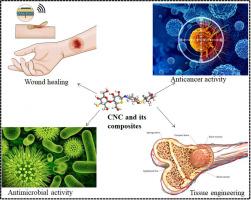From waste to wealth: Advancing sustainability with state-of-the-art progress of cellulose nanocrystals and its composites for biomedical applications: A review
IF 6.5
Q1 CHEMISTRY, APPLIED
Carbohydrate Polymer Technologies and Applications
Pub Date : 2025-09-01
DOI:10.1016/j.carpta.2025.100974
引用次数: 0
Abstract
Recent advances in cellulose nanocrystals (CNCs) have significantly expanded their potential in biomedical applications, driven by their high surface area, biodegradability, and ability to be functionalized for specific biological interactions. The CNC market is projected to reach approximately USD 1 billion by 2030. This review critically examines the latest developments in CNC extraction methods, highlighting conversion of waste to wealth hydrolysis-based techniques that offer improved yield and reduced environmental impact. It also explores innovative surface modification strategies, such as peptide conjugation and polymer grafting, which have enhanced CNCs’ performance in targeted drug delivery and tissue scaffolding. Particular emphasis is placed on CNC-based hydrogels and aerogels, which have demonstrated improved cell adhesion, controlled drug release profiles, and antimicrobial efficacy in recent in vitro and in vivo studies. Despite this progress, issues such as batch variability and cytotoxicity in long-term implantation remain. To address these issues, the review highlights promising directions, including the development of standardized protocols for biological testing, scalable green synthesis pathways, and the integration of CNCs with other nanomaterials. Overall, the review synthesizes emerging evidence that positions CNCs as a viable, multifunctional platform for next-generation biomedical technologies, while outlining practical strategies to bridge the gap between experimental promise and clinical implementation.

从废物到财富:纤维素纳米晶体及其复合材料在生物医学应用中的最新进展:综述
纤维素纳米晶体(CNCs)的最新进展极大地扩展了其在生物医学领域的应用潜力,这得益于其高表面积、可生物降解性和特定生物相互作用功能化能力。到2030年,数控市场预计将达到约10亿美元。这篇综述严格审查了CNC提取方法的最新发展,重点介绍了基于废物转化为财富的水解技术,这种技术可以提高产量并减少对环境的影响。它还探索了创新的表面修饰策略,如肽偶联和聚合物接枝,这些策略增强了cnc在靶向药物传递和组织支架方面的性能。特别强调的是基于cnc的水凝胶和气凝胶,它们在最近的体外和体内研究中已经证明了改善的细胞粘附性,控制药物释放谱和抗菌功效。尽管取得了这一进展,但长期植入的批变性和细胞毒性等问题仍然存在。为了解决这些问题,该综述强调了有希望的方向,包括开发标准化的生物测试方案,可扩展的绿色合成途径,以及将cnc与其他纳米材料集成。总体而言,该综述综合了新出现的证据,将cnc定位为下一代生物医学技术的可行多功能平台,同时概述了弥合实验承诺和临床实施之间差距的实用策略。
本文章由计算机程序翻译,如有差异,请以英文原文为准。
求助全文
约1分钟内获得全文
求助全文

 求助内容:
求助内容: 应助结果提醒方式:
应助结果提醒方式:


